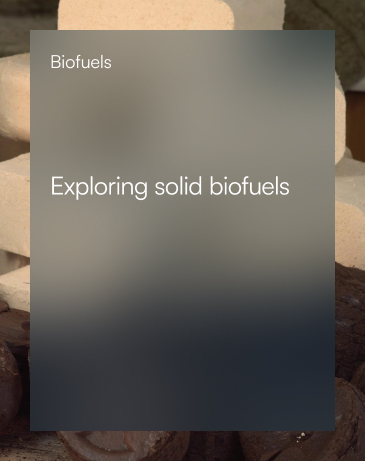Exploring solid biofuels
An Overview: Feedstocks, Types and Environmental Advantages

Solid biofuels are becoming increasingly important as the world transitions from fossil fuels to renewable energy sources. They are a significant component of the energy mix, offering a sustainable alternative to traditional fossil fuels. This article discusses the different types of solid biofuels, the most commonly used feedstocks, how they are produced, and the benefits of using solid biofuels to replace fossil fuels.

What are solid biofuels?
In simple terms, solid biofuels are fuels produced from non-fossil, organic materials known as biomass. This includes wood, dedicated energy crops, and agricultural residues. Biomass contains carbon absorbed by plants through photosynthesis. When this biomass is used to produce energy (bioenergy), the carbon is released during combustion and returns to the atmosphere. As more biomass is produced, an equivalent amount of carbon is absorbed, making modern solid biofuels a carbon-neutral energy source.
According to the IEA, bioenergy is the largest source of renewable energy globally, accounting for 55% of renewable energy and over 6% of the global energy supply.
Types of feedstock for solid biofuels
Solid biofuels can be sourced from both primary and secondary materials:
- Primary Sources: These include biomass specifically grown or collected for biofuel production, such as energy crops and woody biomass from forests and plantations.
- Secondary Sources: These include byproducts from other activities, like agricultural and forest residues, organic fractions of municipal wastes, and animal dung.
Types of solid biofuels
Solid biofuels come in various forms, depending on the level of processing:
- Unprocessed biomass: This includes forestry products, agricultural residues, and livestock wastes. Examples include fuelwood, which is used in its natural state.
- Minimally processed biofuel: This category includes biomass that undergoes minor processing to increase efficiency. Examples are wood chips and municipal solid waste (MSW).
- Processed solid biofuels: These biofuels have uniform characteristics after processing, such as pellets and briquettes.
- Pelletization: Compresses biomass feedstocks under high pressure and temperature to form small, dense, cylindrical pellets. Applied to wood residues, agricultural residues, and dedicated energy crops.
- Briquetization: Compresses loose biomass materials into dense, solid blocks called briquettes. Like pellets, briquettes are made from a wide range of biomass.
- Torrefied biomass and hydrochar
- Torrefied biomass: Biomass that has been pyrolyzed using torrefaction, heated at 200–300°C in the absence of oxygen, resulting in a solid product with higher surface area, calorific value, carbon content, and improved grindability and pelletability.
- Hydrochar: Produced through hydrothermal carbonization at temperatures between 180–250°C in the presence of water, yielding hydrochar with lower ash content, higher calorific value, and higher carbon content than raw biomass.
Advantages of solid biofuels
Solid biofuels offer several advantages over conventional fossil fuels, including:
- Renewability: Derived from renewable biomass feedstocks, solid biofuels are a sustainable energy source that can be replenished over time.
- Carbon neutrality: The combustion of solid biofuels releases carbon dioxide, which is reabsorbed by plants during photosynthesis, making them carbon-neutral.
- Energy security: Solid biofuels can be produced locally from a wide range of feedstocks, reducing dependency on imported fossil fuels and enhancing energy security.
- Waste reduction: Utilizing agricultural and forestry residues, as well as municipal solid waste, for solid biofuel production helps reduce waste and alleviate environmental pollution.
- Economic benefits: The production and use of solid biofuels create new jobs, stimulate rural economies, and promote the development of bio-based industries.
Supporting the transition from fossil fuels
According to the World Bioenergy Association (WBA), solid biofuels such as pellets can play a pivotal role in the transition from fossil fuels by replacing coal and other fossil fuels in both residential heating and industry. The availability of biomass and the versatility of solid biofuels make them a practical choice for industries aiming to lower their carbon footprint.
For instance, the energy industry is increasingly using pellets to replace fossil fuels to substantially lower greenhouse gas (GHG) emissions. Power producers are not the only ones supporting energy from biomass. The United Nations Intergovernmental Panel on Climate Change (IPCC), the world’s leading authority on climate change, has recognized the significant GHG mitigation potential of biomass – able to deliver 80 to 90% emission reductions compared to the fossil energy baseline.
Solid biofuels represent a promising and sustainable alternative to fossil fuels. With their environmental benefits, renewable nature, and potential to enhance energy security, they are set to play a crucial role in the future energy landscape. However, addressing challenges related to efficiency, logistics, land use, and technology will be essential for unlocking their full potential. As technology advances and policies evolve, solid biofuels will become an integral part of the global effort to achieve a cleaner and more sustainable energy future.
Explore sustainable options with Jord fuel pellets
Join the movement towards sustainable energy by exploring Jord fuel pellets, a reliable solution for your heating and energy needs. Visit our website to learn more and make the switch to sustainable fuels
Reference
Manandhar, A., Mousavi-Avval, S. H., Tatum, J., Shrestha, E., Nazemi, P., & Shah, A. (2022). Solid biofuels. Biomass, Biofuels, Biochemicals, 343–370. https://doi.org/10.1016/b978-0-12-819242-9.00017-8




